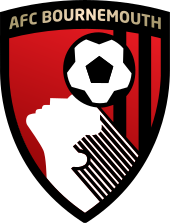

AFC Bournemouth is a professional football club in
Bournemouth, Dorset, that plays in the Premier League,
the top tier of the English football league system. Formed in 1890
as Boscombe St. John's Institute F.C.,
the club adopted their current name in 1972. Nicknamed The
Cherries, since 1910 Bournemouth have
played their home games at Dean Court. Their home colours are red
and black striped shirts, with
black shorts and socks.
AFC Bournemouth have won the second and third tiers of English
football, and were twice runners up of the
fourth tier. They have also won the Football League Trophy, and
the Football League Third Division South Cup.
Bournemouth have spent the majority of their history bouncing
between the third and fourth tier of English
football. Under manager Eddie Howe, they have risen through the
pyramid; the 2015–16 season was AFC
Bournemouth's first ever in England's top division.
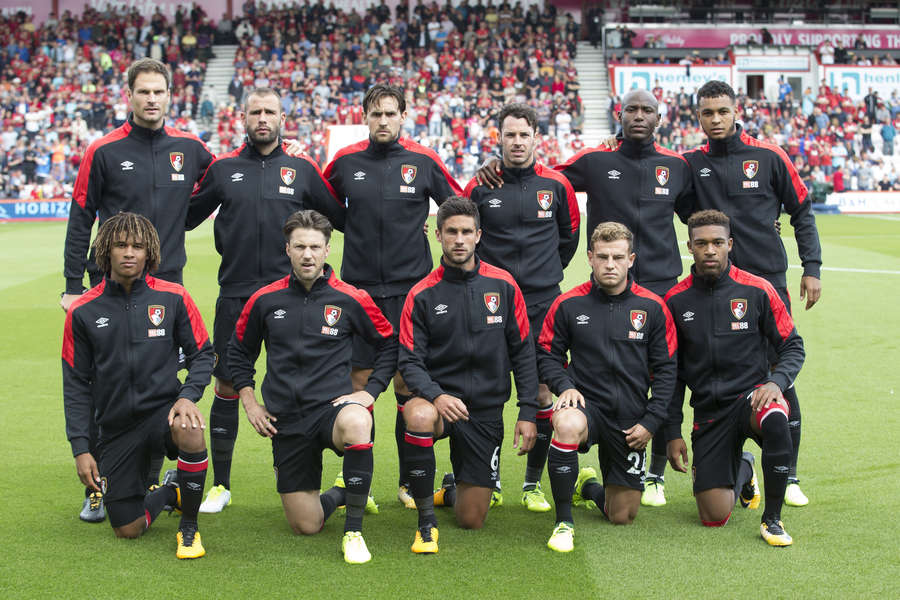
A.F.C. Bournemouth in English football, as of 1919 to the most
recent completed season. The club was originally
known as Boscombe F.C.. The exact date of the club's foundation is
not known, but there is proof that it was
formed in the autumn of 1899 out of the remains of the older
Boscombe St. John's Lads’ Institute F.C.. In
their first season 1899–1900 Boscombe F.C. competed in the
Bournemouth and District Junior League, part
of the Hampshire Football League.
In the season of 1905–06 Boscombe F.C. graduated to senior amateur
football. For the first time during the season
of 1913–14 the club competed in the F.A. Cup. The clubs progress
was halted in 1914 with the outbreak of the war
and Boscombe F.C. returned to the Hampshire Football League. In
1920 the Third Division was formed and Boscombe
were promoted to the Southern Football League. Three years later
the club was promoted to the Football League
Third Division South at which time they renamed themselves to
Bournemouth and Boscombe Athletic Football Club.
The club remain on the records as the longest continuous members
of the Third Division.
AFC Bournemouth 2017/18 | Season highlights
After making the League One play-off semi-finals in 2010–11, and
achieving a mid-table finish in 2011–12,
Bournemouth won promotion to the Championship at the end of the
2012–13 season, putting them in the second
tier of the league for only the second time in their history. In
the 2014–15 season, they won the Championship
title, and earned promotion to the Premier League for the first
time in their history.
Dean Court, currently known as the Vitality Stadium for
sponsorship purposes, is a football stadium in Bournemouth,
England and the home ground of A.F.C. Bournemouth. In 1910
Boscombe F.C. was given a piece of land by the town's
Cooper-Dean family, after whom the ground was named. The land was
the site of an old gravel pit, and the ground
was not built in time for the start of the 1910–11 season. As a
result, the club played at the adjacent King's Park until
moving into Dean Court in December 1910. However, the club
facilities were still not ready, and players initially had
to change in a nearby hotel. Early developments at the ground
included a 300-seat stand.
In 1923 the club were elected to Division Three South of the
Football League, at which point they changed their name
to Bournemouth & Boscombe Athletic. The first Football League
match was played at Dean Court on 1 September 1923,
with 7,000 watching a 0–0 draw with Swindon Town. Subsequent
ground improvements were made following the purchase
of fittings from the British Empire Exhibition at Wembley, which
allowed the construction of a 3,700-seat stand. A covered
terrace was added at the southern end of the ground in 1936.
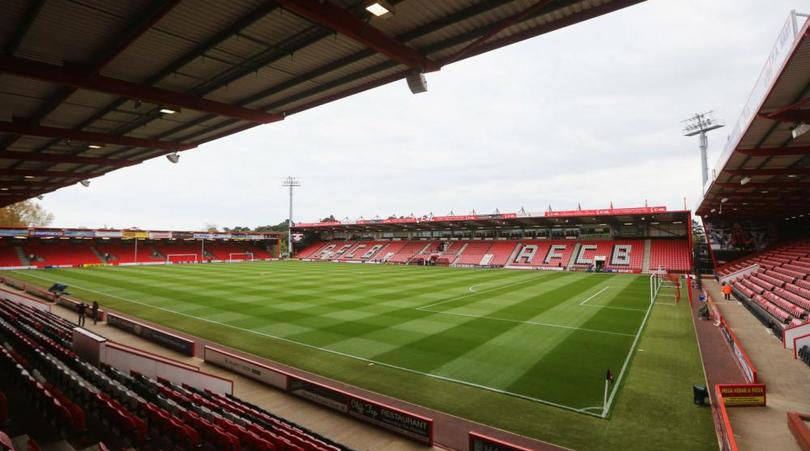
The club's record League attendance was set on 14 April 1948, when
25,495 watched a 1–0 defeat to QPR. The overall
record attendance was set on 2 March 1957, when 28,799 spectators
watched an FA Cup match against Manchester United.
Shortly afterwards, a roof was added to the western stand. The
club also purchased more land behind the northern end
of the ground, with the intention of enlarging the stand and
building a leisure centre. However, the club ran out of money
during its construction and abandoned the scheme in 1984. As a
result, the half-built structure was demolished and housing
was built on that part of the site. The club's lowest Football
League attendance was set on 4 March 1986, when only 1,873
saw a 2–2 drawn with Lincoln City.
The ground was completely rebuilt in 2001, with the pitch rotated
ninety degrees from its original position and the ground
moved away from adjacent housing. Because the work was not
finished in time for the start of the 2001–02 season, Bournemouth
played their first eight games at the Avenue Stadium in nearby
Dorchester. When Dean Court reopened with a game against
Wrexham on 10 November, it gained its first sponsored name,
becoming the Fitness First Stadium. Although it was rebuilt
as a three sided stadium with a capacity of 9,600,seats were
placed on the undeveloped south end in the autumn of 2005.
On 24 February 2004 Bournemouth's James Hayter scored the Football
League's fastest-ever hat-trick at Dean Court, scoring
three goals in 2 minutes and 20 seconds during a 6–0 against
Wrexham. The club sold the stadium in December 2005 in
a sale-and-leaseback deal with London property company
Structadene.
In the 2010–11 a temporary south stand was built, but was removed
during the 2011–12 season after attendances fell.
In July 2011 the stadium was renamed the Seward Stadium after the
naming rights were sold to the Seward Motor Group.
Following Seward entering administration in February 2012, the
ground was subsequently renamed the Goldsands Stadium
in a two-year deal. During the summer of 2013 a 2,400 seat stand
was built on the undeveloped end of the ground as a
result of the club's promotion to the Championship. In July 2013
it was named after former club striker Ted MacDougall.
In August 2014, chairman Jeff Mostyn revealed that the club were
looking at the possibility of redeveloping the stadium
rather than moving to Matchams. With a limited capacity of 11,464,
the club were exploring the option of building a new,
permanent stand and filling-in the stadium's corners should they
continue to be successful in the Premier League. The
naming rights changed once more in July 2015 when the stadium
became the Vitality Stadium.
AFC Bournemouth: Together, anything is possible
In December 2016 the club announced plans to find a new site due
to the ongoing issues regarding ownership of the ground.
In July 2017 the club confirmed it was looking to build a new
stadium near the current site in Kings Park.In 2013 both England
Ladies and Under 16 sides played games at the ground. The stadium
has also been used for music concerts, hosting Elton John
in 2006. It is the only Premier League stadium never to have been
in a Labour constituency.
Boscombe F.C. - Although the exact date of the
club's foundation is not known, there is proof that it was formed
in the autumn of 1899 out of the remains of the older Boscombe St.
John's Institute F.C.The club was originally
known as Boscombe F.C. The first president was Mr. J. C. Nutt.In
their first season, 1899–1900, Boscombe F.C.
competed in the Bournemouth and District Junior League. They also
played in the Hants Junior Cup. During
the first two seasons, they played on a football pitch in
Castlemain Avenue, Pokesdown. From their third season,
the team played on a pitch in King's Park. In the 1905–06 season,
Boscombe F.C. graduated to senior amateur football.
In 1910, the club was granted a long lease upon some wasteland
next to Kings Park as the clubs football ground
by President J. E. Cooper-Dean. With their own ground, named Dean
Court after the benefactor, the club continued
to thrive and dominated the local football scene. Also in 1910,
the club signed their first professional football player B.
Penton.
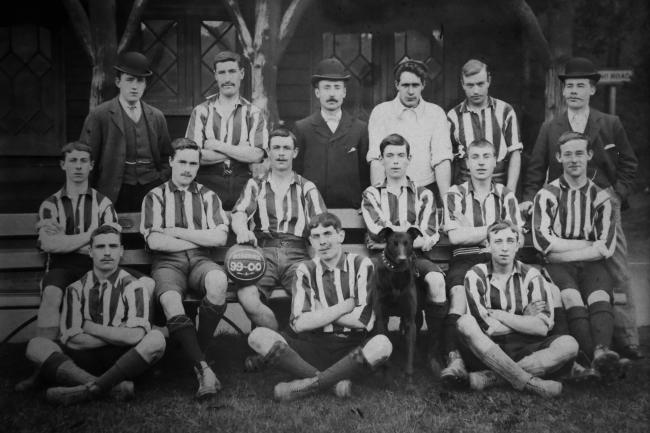
Around about this time, the club obtained their nickname "The
Cherries," with two foremost tales on how the club
gained the nickname. First, because of the cherry-red striped
shirts that the team played in and, perhaps less plausible,
because Dean Court was built adjacent to the Cooper-Dean estate,
which, it is believed may have encompassed
numerous cherry orchards.
For the first time, during the 1913–14 season, the club competed
in the FA Cup. The club's progress, however, was
halted in 1914 with the outbreak of World War I, and Boscombe F.C.
returned to the Hampshire League.In 1920,
the Third Division of the Football League was formed, and Boscombe
were promoted to the rump Southern League,
finding moderate success.
The Rise of AFC Bournemouth: A Brief History
Bournemouth and Boscombe Athletic F.C. - To make
the club more representative of the district, the name
was changed to Bournemouth and Boscombe Athletic F.C. in 1923.
During the same year, the club was elected to
the newly-expanded Football League Third Division. The first
league match was at Swindon Town on 25 August 1923,
which Bournemouth lost 3–1. The first league game at Dean Court
was also against Swindon, where Bournemouth
gained their first league point after a 0–0 draw.
Initially, Bournemouth struggled in the Football League but
eventually established themselves as a Third Division club.
Bournemouth remains on the records as the longest continuous
members of the Third Division.As a league club,
Bournemouth had to wait until after the Second World War before
winning their first trophy. This was accomplished
as they beat Walsall in the Third Division (South) Cup in the
final at Stamford Bridge.
AFC Bournemouth - Under manager John Bond, the club
adopted the more streamlined AFC Bournemouth name in 1972.
At the same time, the club adopted a new badge as a symbol of the
club's progress. The stripes in the background were
based on the club shirt, while in the foreground is the profile of
a player heading the ball, in honour of Dickie Dowsett,
a prolific scorer for the club in the 1950s and 1960s.Their red
and black kit, introduced in 1971, was based on the Milan strip.
This was the era of Ted MacDougall, a prolific goalscorer who, in
an FA Cup tie in November 1971, scored nine goals in
an 11–0 win against Margate.
20th century
The club recorded a famous victory over holders Manchester United
in the FA Cup in January 1984, while they were managed
by Harry Redknapp.Redknapp took Bournemouth into the second tier
of the English league for the first time in their history
as Third Division champions in 1987. After comfortably surviving
in their first season in the Second Division, Bournemouth
made a serious challenge for promotion to the top flight in the
1988–89 season; they ultimately fell away after a poor run
late in the season, but their eventual finish of 12th place
remained their highest-ever in the Football League until the
2013–14 season.
On 5 May 1990, the final day of the 1989–90 season, Leeds United
had the chance to win the Second Division and gain
promotion into the First Division by beating Bournemouth at Dean
Court. Some United fans had already caused trouble
in the town during the morning and the atmosphere was tense as
Leeds won the match by a single goal. Combined with
the results of other matches, this meant that Leeds were promoted
while Bournemouth were relegated. The violence and
destruction by visitors to Bournemouth continued over the holiday
weekend, causing more than £1 million worth of
damage and injury to opposing fans and police officers.
The town's Daily Echo newspaper reported that "spectators,
including many young children, had to run to safety as missiles
were hurled and riot police waded in to control the crowds." The
matter was raised in Parliament by one of the town's MPs.
Financially, the Leeds trouble affected the club for more than a
decade, as Bournemouth were prevented by local police
from staging home games on Bank Holidays (traditionally a popular
day for football) until a game against Shrewsbury
Town on 21 April 2003.
Redknapp remained at the club for two more seasons, both of which
ended with the club falling three points short of
the play-offs. However, mounting financial pressures caused him to
resign his position at the end of the 1991–92 season,
and he subsequently rejoined former club West Ham United as a
coach. He was replaced by Tony Pulis, who built a
much cheaper squad that could only manage two consecutive
17th-place finishes before Pulis walked out of the club,
blaming financial pressures much as his predecessor had done.
Bournemouth went the first few months of the 1994–95 season
without a permanent manager in place, and a dreadful
start saw them bottom of the table for much of the first half of
the season. Despite a minor upturn in form when Mel
Machin was appointed as manager, they looked highly unlikely to
survive, given that there were five relegation spots
in Division Two for that season due to league reconstruction.
However, a late run of form combined with collapses by
relegation rivals Cambridge United and Plymouth Argyle saw them
survive on the last day of the season by just two points.
Machin ultimately remained in charge for six years, most of which
were marked by unremarkable mid-table finishes.The 1998–99
season proved to be arguably the highlight of his tenure, with the
club making a serious play-off challenge for most of the season,
but ultimately falling short and finishing seventh. However, a
drop to 16th place in the 1999–2000 season followed by a bad
start to the following season saw Machin removed from his position
and given the role of director of football.
21st century
Sean O'Driscoll was promoted from the coaching staff in place of
Mel Machin at the start of the 2000–01 season. In O'Driscoll's
first season as manager, Bournemouth narrowly missed out on the
Division Two playoffs, but were relegated a year later in
the new stadium. The board kept faith in O'Driscoll and they were
rewarded with promotion via the Division Three playoffs
in 2002–03. The club became the first to score five goals at the
Millennium Stadium when they beat Lincoln City 2–5 in the
2002–03 Division Three play-off final with goals from Steve
Fletcher, Carl Fletcher (2), Stephen Purches and Garreth O'Connor.
Under O'Driscoll, Bournemouth narrowly missed out on the play-offs
for the 2003–04 and 2004–05 seasons, and just avoided
relegation in the 2005–06 season.
Long-serving player James Hayter scored the fastest league
hat-trick in English Football League history during the 2003–04
season. The Cherries were leading 3–0 against Wrexham thanks to
goals from Stephen Purches, Warren Cummings and Warren
Feeney when Hayter was brought onto the field as a substitute.
With 86 minutes gone, Hayter managed to net three goals in
the space of two minutes and 17 seconds, making the final score
6–0 to Bournemouth.In September 2006, with the team
in eighth in the League, Sean O'Driscoll left to become manager of
Doncaster Rovers. He was replaced by Kevin Bond.
Decline and administration (2008–2009)
In February 2008, Bournemouth were forced into administration,
suffering a ten-point deduction which put them in relegation
trouble. Bournemouth had debts of around £4 million and almost
went out of business completely. The off-field uncertainty
continued throughout the season, with only one, ultimately
unsuccessful, bid for the club accepted, and the club ended the
season being relegated to League Two.Ahead of the 2008–09 season,
the team's future in the Football League was put into
doubt when the league threatened to block Bournemouth's
participation in League Two, due to problems with the team's
continuing administration and change in ownership.
It ordered both Bournemouth and Rotherham United to demonstrate
that they could fulfil all of their fixtures and find a way
out of administration, eventually allowing the club to compete
with a 17-point penalty for failing to follow the Football League
insolvency rules. The new company was also ordered to pay
unsecured creditors the amount offered at the time of the
original CVA (around ten pence in the pound) within two
years.Early into the season, manager Bond was sacked and was
replaced by former player Jimmy Quinn, who would himself leave the
club only a few months later.Former player Eddie
Howe took over as manager with the club still ten points adrift at
the bottom of the league and initially on a caretaker basis,
becoming the youngest manager in the Football League at the age of
31.
At the end of 2008, it was announced that local businessman Adam
Murry had completed the purchase of 50% of the club's
shares from previous chairman Paul Baker. However, in January
2009, Murry missed the deadline to buy Baker's shares.In
the final home game of the 2008–09 season, the Cherries guaranteed
their Football League status by beating Grimsby Town
2–1 with a winning goal ten minutes from time by Bournemouth
legend Steve Fletcher, sparking wild celebrations after a
fairytale
ending to "The Great Escape." They finished their troubled season
with their best away win in 30 years with a 0–4 victory at
Morecambe.In June 2009, a consortium including Adam Murry finally
took over AFC Bournemouth. The consortium included
Jeff Mostyn, former vice-chairman Steve Sly, Neill Blake and
former Dorchester Town chairman Eddie Mitchell.
Rise to the Premier League (2009–2015)
Howe's first full season in charge brought success as Bournemouth
finished second in League Two to earn promotion with
two games to spare. Howe subsequently left the club for Burnley
during the following season; his successor, another former
Bournemouth player, Lee Bradbury, led Bournemouth to the League
One play-offs. The two-legged semi-final against Huddersfield
Town finished 3–3 after extra time, and Huddersfield went through
the final by winning the penalty shoot-out 4–2. Bradbury
was unable to lead Bournemouth to another promotion challenge in
the 2011–12 Football League One, placing 11th after
a season of indifferent results, and was replaced by youth team
coach Paul Groves for the final games of the season.
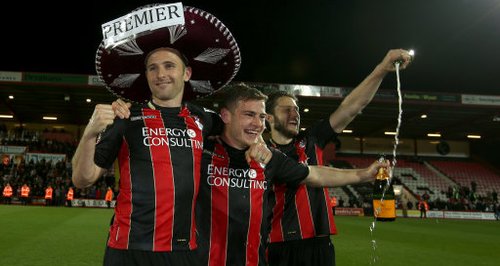
Groves remained in charge at the start of the 2012–13 season, only
to be sacked in October 2012 following a start which left
the club near the bottom of the table. Eddie Howe returned as
manager, and not only did he pull the club away from their
early-season relegation battle, they achieved promotion to the
Championship, returning to the second-tier of English football
for the first time since 1990. The club also revealed a new club
crest. After a promising start to life in the Championship, the
club was handed a fourth Round FA Cup tie with Premier League club
Liverpool which ended in a 2–0 loss. Bournemouth
finished their first season back in the Championship in tenth
place, their highest ever position in the Football League.
On 25 October 2014, Bournemouth won 8–0 away at St. Andrew's
against Birmingham City. It was the first time that the Cherries
had ever scored eight goals in a league game and their largest
winning margin in the league (barring a 10–0 win over Northampton
Town in September 1939, which was discounted after the league was
abandoned due to the Second World War). The club
followed up this success with a 2–1 victory over Premier League
side West Bromwich Albion in the League Cup, reaching
the quarter-finals of the competition for the first time.
Bournemouth were again drawn against Liverpool but lost 3–1.
The club spent most of the 2014–15 season near the top of the
table, and a 0–3 win away at Charlton Athletic on the final day
of the season was enough to clinch the Championship title and a
first ever promotion to the top flight of English football.
Premier League era (2015–present)
AFC Bournemouth's first ever game in the top flight of English
football was a 1–0 defeat home to Aston Villa played on 8 August
2015. Early on in the 2015–16 season the team was beset by a
number of crippling injuries, including to their captain, Tommy
Elphick and their star striker from the previous season, Callum
Wilson, the latter of which was injured for the majority of the
season. The team struggled for most of the first half of the
season until a turning point was reached during a game at Dean
Court against Everton in which Junior Stanislas scored a goal in
the seventh minute of stoppage time to tie the game. From
there, AFC Bournemouth defeated Chelsea and Manchester United in
back-to-back wins. The team eventually finished 16th
in the league, securing their Premier League status for another
year.
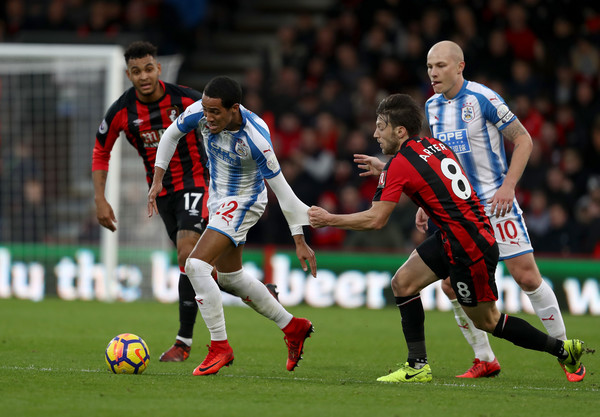
Their second season, despite being largely tipped to suffer second
season syndrome, they defied all odds to finish in 9th place.
Their squad was largely defined by the highly publicized loans of
Jack Wilshere from Arsenal and Nathan Aké from Chelsea,
but also by the strong form of Josh King, who scored 16 goals in
36 appearances, and the £15 million pound move of Jordon
Ibe from Liverpool. A weak start to the season saw them in the
relegation zone for the first three weeks, but after a 1–0
victory against West Bromwich Albion, they never again dropped
below 16th place in the table. Key points of the season
occurred when they soundly defeated Hull City 6–1 and defeated
Liverpool 4–3, both of which helped their survival push
at the end of the season, when they went unbeaten in the last five
matches and earned 11 points from 15.
In preparation for the following season, Howe signed Aké
permanently for a club-record fee,while Asmir Begović and Jermain
Defoe also signed deals at Dean Court. The season began poorly,
with the team losing their first 4 matches.However,
a run of good form through late December and January saw them
steer clear the relegation zone, and saw Howe earn
his second Premier League Manager of the Month award. They also
won 2–1 at home against Arsenal F.C and, more
famously, a surprising 3–0 win at Stamford Bridge against Chelsea.
The team battled inconsistent form the rest of the
season, but still managed a 12th place finish.
AFC Bournemouth are heading for the Premier League
The team's colours have varied slightly throughout the club's
history. Starting off playing in red and white stripes,
Bournemouth
have also played in all-red shirts, red with white sleeves, and
mostly, since 1990, in red and black stripes, similar to that of
Milan.
A predominantly red shirt was chosen for the 2004–05 and 2005–06
seasons before a return to the stripes for the 2006–07
season due to fan demand.
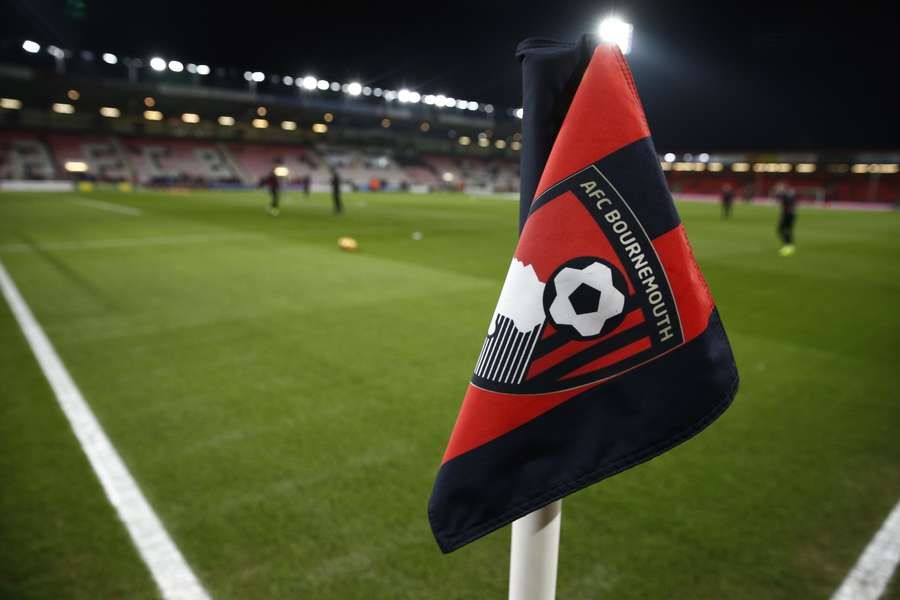
Since 2017 AFC Bournemouth's kit has been manufactured by Umbro.
Previously it has been made by Umbro (1974–78, 1983–86),
Adidas (1978–81), Osca (1982–83), Henson (1986–87), Scoreline
(1987–90), Ellgren (1990–92), Matchwinner (1993–95), Le Coq
Sportif (1995–96), Patrick (1996–2000), Super League (200-01), TFG
Sportswear (2001–03), Bourne Red (2003–08), Carbrini
Sportswear (2008–11, 2014–15), Fila (2011–14) and JD Sports
(2015–17).
Their shirts are currently sponsored by Mansion.com. On 2017–2018
season, the Mansion.com logo will appear on the left shirt
sleeve of AFC Bournemouth's home and third shirts. In addition,
Casino.com, which is a subsidiary of Mansion, will feature on
the sleeve of the club's away shirt. Before this, sponsors have
been Reg Heynes Toyota (1980–82, 1983–85), Coopers Beers
(1985–87), Canberra Homes (1987–88), Nolan (1988–89), A1
Windscreens (1990–92), Exchange & Mart (1992–93), Frizzell
(1993–97), Seward (1993–2006), Focal Point (2006–08, 2011–12),
Carbrini Sportswear (2008–11), and Energy Consulting (2012–15).
Football League Championship
- Champions: 2014–15
Football League One
- Champions: 1986–87
- Runners-up (2): 1947–48,
2012–13
Football League Two
- Runners-up (2): 1970–71,
2009–10
- Play-off winners: 2002–03
- Promoted: 1981–82
Southern League
- Runners-up: 1922–23
Football League Trophy
- Winners: 1983–84
- Runners-up: 1997–98
Football League Third Division South Cup
- Winners: 1945–46
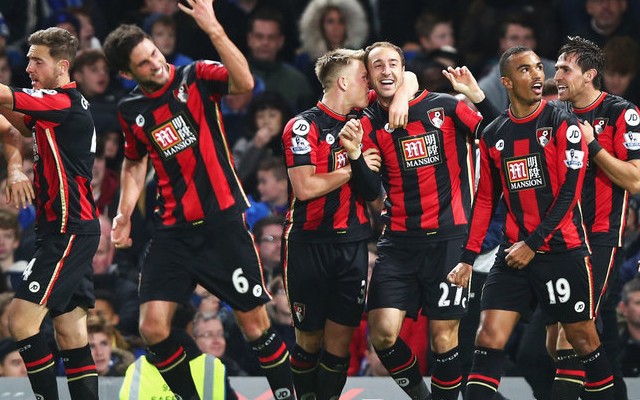
AFC Bournemouth Goals of the Season | 2017/18